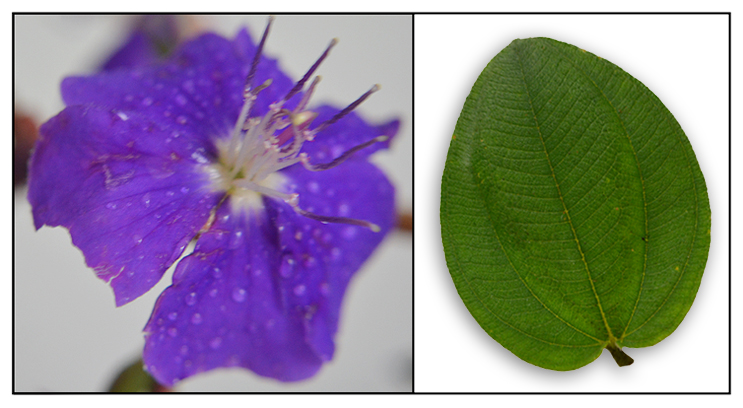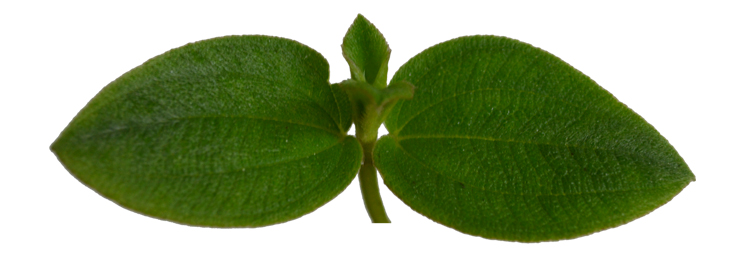
Botany
Glory bush is a shrub growing to a height of 4 meters, with 4-angled, reddish and rough branches. Leaves are simple, opposite, 5-nerved, ovate or oblong-ovate, up to10 centimeters long and 4 centimeters wide, hairy above and smooth below, with finely serrate margins. Flowers are showy, with rosy purple to violet petals, up to 5 centimeters long. Stamens are 10, purple. Fruit is a capsule.
Distribution
- Recently introduced in Baguio.
- Native to Brazil.
 Constituents Constituents
- Leaves have yielded flavonol glycosides as quercetin 3-O-rhamnopyranoside and quercetin 3-O-ß-D-glucopyranoside.
- Stems have yielded hydrolyzable tannin oligomers, mainly ellegatannins known as nobotanins.
- Flowers have yielded anthocyanins, malvidin and peonidin derivatives.
- Hexane extract of leaves yielded glutinol (1), taraxerol (2), a mixture of α- and β-amyrins (3, 4), β-sitosterol, and ursolic (5) and oleanolic (6) acids as a mixture. An ethanolic extract yielded only ß-sitosterol. Methanol extract yielded β-sitosteryl β-D- glucopyranoside, the flavonoids avicularin (7) and hispidulin 7-O-β-D-glucopyranoside (8) [16], and two mixtures, one constituted of asiatic and arjunolic acids (9 and 10) and the other one of quadranoside IV (11) and arjun- glucoside II (12). (See study below) (1)
- Leaf extract yielded three new hydrolyzable tannins, nobotanins L, M and N. (5)
- Major pigment found in the flower was identified as 3-O-[6-O-(E)-p-coumaroyl-ß-D-glucopyranosyl]-5-O-(2--acetyl-ß-D-xylopyranosyl) malvidin. (9)
Properties
- Studies have suggested antioxidant, antileishmanial, PARG-inhibitor, phytoremediative properties.
Parts used
Leaves, stems, flowers.
Uses
Folkloric
- No reported folkloric medicinal use in the Philippines.
- In Brazil, infusion used for stomach problems.
Studies
• Secondary Metabolites / Leaves and Stems / Known Activities of Metabolites: Chemical study of leaves and stems of T. urvilleana yielded ten triterpenes, two flavonoids, two sterols, and NH4Cl. Compound 10 (arjunolic acid) has been considered antioxidant, antifungal, antibacterial, anticholinesterase, antiasthmatic, and anti-diabetic. ß-amyrin has also shown antidiabetic potential. Glutinol has shown cytotoxicity against four human cancer lines and also shown anti-inflammatory activity. (1)
• Malvidin / Anthocyanin from Flowers: Study isolated an anthocyanin from the purple flower petals of T. urvilleana, identified as malvidin 3-(p-coumaroylglucoside)-5-glucoside. (2)
• Anthocyanin Stability Study: Study showed fully formed but unopened bud had the highest amount of total anthocyanin extracted from fresh petals. The ideal suitable storage is in acidic conditions in the dark. Results suggest a potential usage of colored anthocyanins as natural food colourants and shelf life indicator for acidic foods. (4)
• Antileishmanial Activity: In vivo study of crude extracts showed antileishmanial activity in the following plants: T. purpurea, A. rohituka, S. chirata, Tibouchina semidecandra and T cordifolia. (6)
• PARG Inhibitor / Nobotanin B: Excessive activation of poly(ADP-ribose) polymerase 1 (PARP1) leads to NAD+ depletion and cell death during ischemia and other conditions that generate extensive DNA damage. Nobotanin B, extracted from the plant Tibouchina semidecandra Cogn. is a potent PARG inhibitor. (7)
• Aluminum Accumulation in Leaves: Study evaluated the differences in characteristics of Al accumulation (i.e., accumulation potential, chemical form, and localization) in three woodly Al accumulators: Symplocos chinensis, Melastoma malabathricum, and Tibouchina urvilleana. Oxalate was partly involved in the internal Al detoxification mechanisms in leaves of all three Al accumulators. The order of Al accumulation potential under hydroponic conditions was SC-MA>TU. (8)
Availability
Wild-crafted.
Seeds in the cybermarket.
|

![]()




 Constituents
Constituents